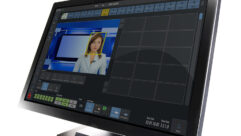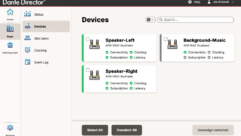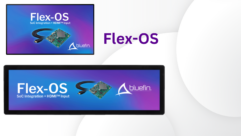The Future Is Now
Dec 1, 2003 12:00 PM,
By Peter Putman
Many years ago, a lovable bunch of baseball players known as the Brooklyn Dodgers used to go down fighting year after year in the World Series at the hands of the New York Yankees. Their rallying cry after each agonizing loss became, “Wait ’til next year!” Eventually “next year” arrived in 1955 as Dem Bums put down the mighty Yanks four games to three.
Even the most skeptical observers of the display and interfacing industry had to admit that next year also arrived in 2003 with respect to large-screen imaging and video signal processing. In fact, the future not only arrived, it swept over the systems integration and pro-A/V landscape with a vengeance.
Technologies such as plasma display panels, thin-film transistors (TFT) LCD monitors, digital light processing (DLP), IP network signaling and control, and wireless 802.11 devices have not only matured but they are also fast becoming commodity products that are sold to the public through any number of retail channels.
One indicator that the pace of display technology is changing perhaps too rapidly is the number of people who are reeling from the number of acronyms and new terms deluging the market. From DLP and D-ILA to TFT LCD, LCoS and HTPS to 480p, 720p, 768p, 12 by 10, SXGA plus, and 2K, confusion is but a few terms away.
All of this chaos has been brought about largely by the move from raster-based electronic imaging (which has worked well since the 1920s) to fixed-pixel imaging. By finally breaking the link between resolution and image brightness, fixed-pixel displays have brought entire categories of display products into existence, not to mention developing industries such as electronic cinema and digital signage.
This avalanche of fixed-pixel displays runs the gamut from supersmall microdisplay imagers all the way to towers of LEDs; from a portable video/data projector that weighs less than two pounds to stadium signs and scoreboards that routinely exceed 100 feet in length.
Just as the displays have changed, so has the content shown on these displays. People are no longer saddled with composite interlaced video. Indeed, you can mix and match any number of video sources, progressive and interlaced, at virtually any input resolutions and switch, dissolve, mix, and even tile them at any output resolution.
The costs of application-specific integrated circuits used in video scalers have also dropped, and RAM has become cheap, allowing the development of powerful, high-resolution multi-image processors for all kinds of staging and command/control applications. In short, if you want to achieve a certain visual effect or look at a given resolution, you can pretty much do what you wish with off-the-shelf components.
Here’s a look at the significant developments in several product categories for the past 12 months.
PROJECTORS
There was a time when front projectors dominated the trade press headlines. The first front LCD projectors (640-by-480 resolution, 400 to 500 lumens) made an appearance in 1990. These big brutes weighed close to 100 pounds and used large, expensive high-pressure lamps.
Now you can pick up dozens of XGA (1,024 by 768) projectors that weigh less than ten pounds and will put an honest 2,000 lumens up on the screen for less than $5,000. What is more, many of these projectors are being permanently installed in classrooms and meeting rooms.
The cost of these projectors and the technology turnover cycle has also led purchasers to think in terms of outright replacement instead of repairs when there are equipment breakdowns. Although it may make sense to have a $5,000 projector serviced after a year of use (assuming the manufacturer’s warranty hasn’t expired), a model that is three or more years old is probably destined for the scrap heap.
As a result, projectors just aren’t big news anymore. What draws interest now are the many add-ons such as wireless and wired network control, wireless presentations, and built-in JPEG/BMP/PPT file readers and players. But those bells and whistles merely serve to maintain price points for a little while. The market has too many players, and pricing has become cutthroat.
In the business, educational, and professional markets, you can pretty much buy whatever level of image brightness you wish. Trouble is advancements in projector performance are incremental nowadays — an extra 500 lumens doesn’t justify the purchase of new models when your older versions are already chugging along at 2,000 to 2,500 lumens.
Network (IP) interfacing to projectors is a real boon to distributed networks of projectors with corporate and educational campuses. Courses covering IP and A/V convergence consistently have the highest attendance at InfoComm each year, and 2003 was no exception. Manufacturers including Sony, Epson, Sanyo, Barco, Mitsubishi, Christie, and InFocus/Proxima are all active in this area with interfaces and software for control.
The biggest news for 2003 is the continued downward price spiral. Consulting the recent 2003 Projector Buyer’s Guide (published in the November 2003 issue of Video Systems), you’ll see that there are now two dozen models of SVGA and XGA front LCD and DLP projectors that retail for less than $2,000. With street pricing, the number of projectors for less than $2,000 will likely increase by 50 percent.
That’s not so good news for traditional dealers nor is the expanding number of Internet sales outlets. But it is great news for previously underserved markets such as education and houses of worship. Toss in wireless 802.11 goodies and network control, and there are a raft of new installation opportunities and sales that can be built around these affordable displays.
FLAT SCREENS
Plasma and LCD monitors and integrated TVs have gone from expensive curiosities to mainstream products in just five years. Today it is possible to purchase numerous plasma monitors in sizes up to 42 inches for cheaper than $5,000, and 50-inch screens can be had for less than $10,000. Surprisingly, the largest plasma retailer isn’t even a company in the pro A/V business — it’s Gateway, a big player in the PC world.
Many Asian manufacturers have tied their companies’ futures on flat-screen imaging technology. During the past seven years, several major players (Mitsubishi, Hitachi, and Sharp) have discontinued or announced they will stop manufacturing picture tubes in favor of plasma and LCD panels. How long will it be before Toshiba, Panasonic, and Sony follow in those companies’ footsteps?
Overproduction and a sluggish world economy have led to all kinds of OEM deals being made and lots of price cuts (tantamount to dumping). As a result, some major players in the home theater and pro-A/V markets have decided it’s simply easier to buy LCD and plasma glass from existing manufacturers rather than develop proprietary manufacturing capabilities.
The mass migration away from tubes to flat screens has also driven the development of pure digital interfaces, such as DVI-D. Concurrently, issues of copy protection and digital content management have led manufacturers of plasma and LCD TVs and digital TV set-top receivers to adopt a secure form of DVI, high-definition copy protection (HDCP), as the interface of the future for the consumer market.
The biggest development in 2003 was the introduction of big-screen TFT LCD monitors and TVs. Three companies (LG, Sharp, and Samsung) dominate this market, and most OEM products come from these factories. All of them have shown the ability to manufacture LCD monitors in sizes larger than 50 inches, with 60 inches around the corner.
The significance of this development is that at some point in the future, customers will have a choice between technologies in a given flat-screen size. More important, manufacturers will also have that same choice, and there is already talk that the 42-inches-and-smaller market segment will be conceded to LCD within a couple of years.
The competition between LCD and plasma is interesting. Plasma offers higher brightness and more saturated colors, but LCD counters with reduced power consumption and weight. More important, the backlights used in LCD monitors should outlast the life of the phosphors in a plasma monitor.
From a manufacturing standpoint, the choice to make one or the other may hinge on the development of yet another display technology: organic light-emitting diodes (OLEDs). More than 30 companies are engaged in OLED research and development, including Sony, Samsung, LG, DuPont, Philips, Osram, Kodak, Toshiba, and Mitsubishi.
These thin, low-voltage emissive displays show great potential for use in small portable electronic gadgets and ultimately as computer monitors and portable TVs, assuming issues with the cost of driving electronics and LED life can be resolved.
Here’s the connection to LCD: the silicon controllers for both OLED displays and LCD monitors are largely the same. If a given manufacturer makes OLEDs and LCD monitors, a single CMOS controller factory can accommodate both fabrication lines.
It’s not out of the realm of possibility that plasma technology might go the way of the dodo and hand-cranked engines within a decade — not because its image quality is inferior (plasma still looks better than most LCD monitors do with video sources) but because of simple economics.
As with the projector market, the glut of product due to factory overcapacity is working hand-in-hand with OEM deals and many aggressive Asian resellers to force prices down. Pro-A/V dealers now have to compete with toll-free numbers and Internet sales outlets as well as discount retail stores like Costco and Sam’s Club and big-box retailers such as Circuit City and Best Buy.
The good news is that many of these products are at the centerpiece of a custom install, whether it be a home theater or a conference room. So opportunities are still there to put together an integration job, even if the markups of old have gone by the wayside. Speaking of integration, IP control of flat screens hasn’t caught on nearly as fast as in the projector world, but that trend is coming.
The preponderance of flat-screen displays has given birth to a new market of digital signage. The retail, command and control, public safety, and transportation industries are all over digital signage, using everything from data walls made of tiled plasma to enormous LED displays that make up entire walls.
Oddly enough, only Pioneer has made integration of its products easier by offering expansion slots for aftermarket video/computer signal interfaces. Look for more plasma and LCD manufacturers to follow suit. Some solutions, such as Panasonic’s line of plug-in cards, seen at InfoComm 2003 were still proprietary, but they are a step in the right direction.
INTERFACING
It no longer matters what source video you start with nor what output resolution you want — there’s a scaler that will fit your needs. In 2003 the big news was continued downward price pressure along with some amazing multichannel image tiling and overlay systems, topped by Vista’s Montage system.
Folsom Research also has shown panoramic image scaling and edge-blending products with individual channels of tiled video. These products are tailor-made for front projection (large venues, staging, concerts, and special events) but are equally at home in command and control (network monitoring, public safety, process control, and transportation).
Many dealers and integrators have reported activity in retrofitting and new construction of small- to midsize conference rooms, augmented by some sort of front-projection system or flat-screen display. (Many have incorporated video- and audioconferencing products, as well.) As a result, the market for presentation switcher/scalers with audio continues to grow as prices decrease.
The continued interest in IP networking is showing up in many interfaces. Companies such as Extron, Crestron, and AMX are bringing interfaces to market with IP addresses for audio/video networks. The main advantage of such connections is for remote monitoring, control, and status updates — few end-users are sending still photos or PowerPoint slides along these networks.
The handful of projector and flat-screen manufacturers that provide aftermarket expansion slots for video and interface cards are supported by a few persistent companies, including Aurora Multimedia and Altinex. These slots let the end-user and integrator customize the display and are perfect for IP signal and control.
DVI interfaces are also slowly appearing on more and more products, and there are now companies such as Gefen that are cranking out DVI signal splitters, switchers, and distribution amps. The consumer implementation of DVI high-definition multimedia interface is still in its nascent stages with many issues to be resolved, not the least of which is compatibility between DVI-equipped signal sources (set-top boxes, DVD players) and displays that will not support HDCP.
A majority of flat screens larger than 31 inches and projectors that weigh more than six pounds now include some sort of DVI connection, though each interface’s compatibility with HDCP is not always made clear in the product literature.
The market for pure video scan converters continues to decline in favor of do-it-all boxes like TV One’s groundbreaking (for the price) C2-770 video scaler/scan converter/format converter. Such a product fulfills a wealth of needs in one chassis, and many of these all-in-one video devices now offer optional SDI interfaces.
WHAT NOW?
In many ways, next year has already come and gone. Get used to commodity pricing for every type of display product, except for high-end projection and flat-screen systems. The Pandora’s box of lower pricing has been opened, and it can never be closed again. However, with all of these competing products that look alike and are priced within a few dollars of each other comes a great deal of end-user confusion.
The trick is to combine the video signal sources with the best interfaces and the most appropriate displays to seamlessly integrate a given project. Any plasma screen can show video, but many of them need serious help with deinterlacing, motion compensation, and pixel scaling — ditto for front projectors. There’s no shortage of bright images, but signal processing is still all over the place in terms of quality.
So what will drive the market in 2004? The continued expansion of markets such as digital signage, command and control, education, and networking will be at the forefront. Some companies such as Sony are endlessly optimistic about IP connectivity, and every piece of pro-A/V gear they make will have an IP address. Other manufacturers are not so easily convinced.
But there can be no doubt that pure digital signal distribution is the new thing, whether it be a variation of high bit-rate SDI and HD-SDI, a visual interface such as DVI, or a network interface. Look for more display products to incorporate one or more of these interfaces in 2004 and expect to hear lots more hype and news about IP network control as the industry moves away from analog signal distribution.
Pete Putmanowns PHP Communications in Doylestown, Pennsylvania. The author of The Toastmasters Guide to Audio/Visual Presentations, Putman is also a regular columnist in Sound and Video Contractor.










